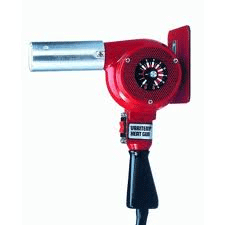
last updated
Flame drying
There are different ways to prepare the glassware. An easy way is to assemble the set up and then purge it with an inert gas for an extended time. This procedure will remove the majority of the air, but it will leave behind the moisture (hydroxyl groups) and air absorbed on the glass itself. In order to remove them, the glassware has to be heated with a heat gun (or Bunsenburner) while purging it (Make sure that you remove all flammable materials from the area to prevent fires. The heat guns in the laboratory are industrial scale heat guns. They allow temperatures up to 500oC.

Upon completion of the heating, the filament inside the heat gun has to cooled down to prevent it from melting. The heat gun should be placed on teh floor after the nozzle cooled down a little. This technique works for less sensitive materials.
In Chem 174, air and moisture are removed from the glassware by heating the glassware in a dynamic vacuum (Schlenk line). This procedure is usually more efficient in terms of removal of surface materials. Glass joints and stopcocks should not be heated directly. They will undergo slight deformation and start to leak. Also, the high vacuum grease (Dow corning) that is used to lubricate the joints starts to melt at ~250 oC. It will get sucked into the setup and the product will be most likely be contaminated with it. The glassware should be hot to the touch and allowed to cool down under vacuum before refilling it with inert gas (Careful: Check who else is connected to the inert gas supply!). This process should be repeated at least once.
For extremely sensitive applications, the glass surface can be passivated with trimethylsilyl chloride (TMSCl). This procedure is very elaborate and will not be used in Chem 174.